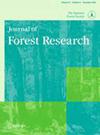Research and project activities for breeding of Cryptomeria japonica D. Don in Japan
IF 1.1
4区 农林科学
Q3 FORESTRY
引用次数: 3
Abstract
ABSTRACT Breeding of sugi (Cryptomeria japonica) started with the selection of first generation plus-trees in the 1950s in Japan. The initial aim of the breeding program was to improve growth performance, and the aim has been extended to tolerance to adverse meteorological conditions, amelioration of wood properties, mitigation of pollinosis, and adaptation to climate change. These changes have arisen in response to shifts in social demands from timber production to management of diverse forest functions over time. Currently, the focus of C. japonica breeding is focusing on the selection and deployment of second-generation plus-tree clones and establishment of breeding populations for the third-generation plus-trees. In this review, these activities and achievements are described, and prospects of the future breeding initiatives, including the feasibility of breeding for climate change, are discussed.日本柳杉育种研究与项目活动
杉木(Cryptomeria japonica)的选育始于20世纪50年代日本第一代正树的选育。育种计划的最初目标是提高生长性能,目标已扩展到对不利气象条件的耐受性,改善木材性能,减轻授粉和适应气候变化。随着时间的推移,社会需求从木材生产转向多种森林功能的管理,这些变化随之产生。目前,粳稻育种的重点是第二代正树无性系的选择和配置以及第三代正树育种群体的建立。本文综述了这些活动和成果,并对未来育种工作的展望,包括气候变化育种的可行性进行了讨论。
本文章由计算机程序翻译,如有差异,请以英文原文为准。
求助全文
约1分钟内获得全文
求助全文
来源期刊

Journal of Forest Research
农林科学-林学
CiteScore
3.00
自引率
6.70%
发文量
62
审稿时长
3 months
期刊介绍:
Journal of Forest Research publishes original articles, reviews, and short communications. It covers all aspects of forest research, both basic and applied, with the aim of encouraging international communication between scientists in different fields who share a common interest in forest science.
 求助内容:
求助内容: 应助结果提醒方式:
应助结果提醒方式:


